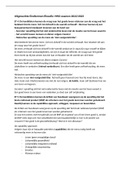Samenvatting
Marketing Environment 2 (Marketing 3 Exam) Summary; chapters 12, 13, 14, 15, 16 & 17
- Vak
- Instelling
Created for Saxion Enschede’s third Marketing exam; “Marketing Environment 2”. Content taken primarily from the slides (available here: https://goo.gl/NQuLZv), & the Principles of Marketing book. Contain the following chapters in full: 12, 13, 14, 15, 16 & 17
[Meer zien]












